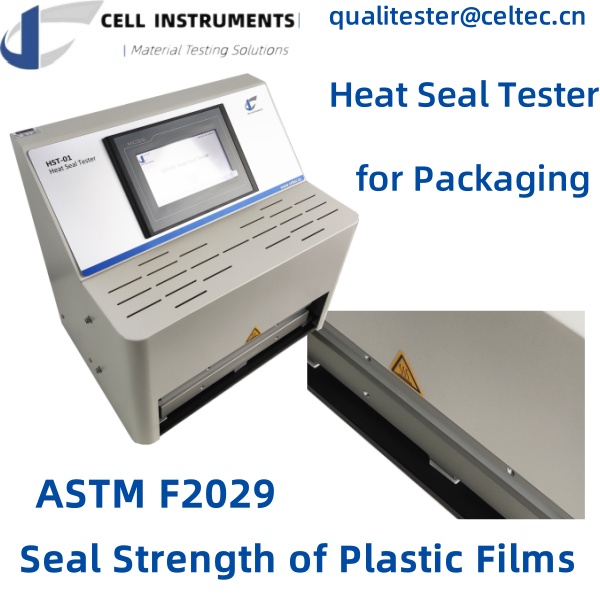소개
Seal strength is a critical factor in the performance and durability of plastic films, especially in industries such as packaging, pharmaceuticals, and food processing. Understanding and accurately measuring the seal strength of plastic films is essential for ensuring product safety and integrity. This article delves into the importance of seal strength, the testing methods outlined in ASTM F2029, and how the right equipment, like a heat seal tester for packaging, can help achieve optimal results.
What is Seal Strength?
Seal strength refers to the force required to separate two bonded materials, which is a key indicator of the effectiveness and durability of the seal. In plastic films, this strength determines the ability of packaging to protect its contents from external factors such as moisture, air, and contamination. Poor seal strength can lead to product spoilage, contamination, or failure during transport, which underscores the need for rigorous testing.
Importance of Seal Strength in Plastic Films
In industries that rely heavily on plastic films for packaging, such as food, pharmaceuticals, and medical devices, seal strength directly impacts product quality and consumer safety. A strong seal ensures that the packaging remains intact under various conditions, preserving the product’s freshness and efficacy. This is particularly vital in medical and pharmaceutical applications, where the consequences of a failed seal can be severe.
ASTM F2029: The Gold Standard for Seal Strength Testing
ASTM F2029 is the standard test method for making heat seals for determining the heat sealability of flexible webs as measured by seal strength. It provides a comprehensive framework for evaluating the seal strength of plastic films, ensuring consistency and reliability in testing.
Key Testing Procedures in ASTM F2029:
-
시험편 준비:
- Samples of the plastic film are prepared to specific dimensions.
- The cleanliness and uniformity of the samples are ensured to avoid any influence on the seal quality.
-
테스트 매개변수 설정:
- Appropriate temperature, pressure, and dwell time are selected based on the material.
- These parameters are recorded to maintain consistency across tests.
-
테스트 수행:
- The sample is placed between the heated sealing bars, and the pre-set pressure is applied.
- After the designated dwell time, the sample is removed and allowed to cool before further analysis.
-
씰 강도 측정:
- A tensile testing machine is used to pull the sealed sample apart.
- The force required to break the seal is measured, providing a quantitative assessment of the seal strength.
The Role of Heat Seal Testers in Ensuring Compliance
Using a heat seal tester specifically designed for packaging materials is crucial in adhering to ASTM F2029 standards. Cell Instruments’ Heat Seal Tester is an advanced tool that ensures precise evaluation of seal strength in plastic films. With features like customizable settings and automation options, it offers consistency, accuracy, and repeatability in testing, making it an indispensable tool for quality assurance.
Applications of Seal Strength Testing
Seal strength testing is vital across various industries:
- 포장: Ensures that flexible packaging materials maintain product freshness and safety.
- 제약품: Verifies the integrity of blister packs and other packaging, ensuring compliance with regulatory standards.
- 의료기기: Assures the reliability of sterile packaging, crucial for patient safety.
- 음식과 음료: Guarantees the safety and quality of sealed food products, vital for consumer protection.
결론
Ensuring the seal strength of plastic films is essential for maintaining the integrity and safety of packaged products. By adhering to ASTM F2029 standards and utilizing advanced equipment like a heat seal tester for packaging, companies can achieve reliable, consistent results that meet industry expectations.
자주 묻는 질문
- What is the purpose of seal strength testing?
- Seal strength testing ensures that packaging materials can protect their contents from external factors like moisture, air, and contamination, preserving product quality and safety.
- How does ASTM F2029 help in seal strength testing?
- ASTM F2029 provides standardized procedures for making and evaluating heat seals, ensuring consistent and reliable testing across various materials.
- What industries benefit most from seal strength testing?
- Industries such as packaging, pharmaceuticals, medical devices, and food processing benefit significantly from seal strength testing to ensure product safety and compliance with regulations.
- What are the key parameters in a heat seal test?
- The key parameters include temperature, pressure, and dwell time, which must be carefully selected and controlled to achieve accurate results.
- Why is a heat seal tester important for packaging?
- A heat seal tester ensures that the seals in packaging materials meet quality standards, providing reliable and repeatable results that are crucial for quality assurance in various industries.

